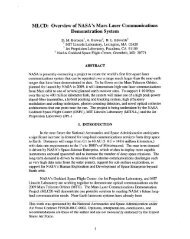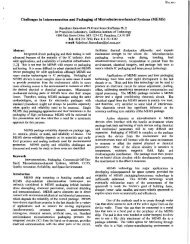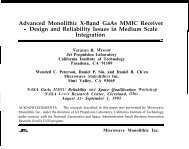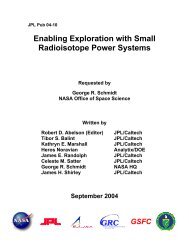f - NASA Jet Propulsion Laboratory Technical Reports Server
f - NASA Jet Propulsion Laboratory Technical Reports Server
f - NASA Jet Propulsion Laboratory Technical Reports Server
You also want an ePaper? Increase the reach of your titles
YUMPU automatically turns print PDFs into web optimized ePapers that Google loves.
The sensors are the Quantum Well Infrared Photodetector (QWIP), the Active Pixel Sensor (APS), and the Delta Dopped<br />
ultraviolet charged-coupled device (UV CCD). These three sensors cover the wavelength ranges 7.8 to 9, 0.4 to 1.0 and<br />
0.3 to 0.4 pm, respectively. VIGILANTE sensors can be queued to assist in the ATR functions of detection, classification,<br />
and precision tracking. For example, in a ballistic missile application, UV wavelengths (0.3 to 0.4 pm) could provide<br />
plume detection, IR (7.8 to 9pm) is suitable for cold body sensing / classification, and the visible wavelengths (0.4 to 1.0<br />
pm) can provide aim-point selection in the final approach / intercept. Eventually the VIGILANTE sensors may be used for<br />
simultaneous fusion of the data from multiple wavelengths. VIGIL provides realistic image conditions for airborne targets<br />
seen from above. To point the sensors toward the target (before the ANTE ATR becomes operational), both the helicopter<br />
and VTV are equipped with GPS receivers, to provide the pointing information<br />
ANTE malog Neural Three-dimensional processing<br />
- Experiment) is a prototype image-processinghargetrecognition<br />
computer architecture based upon 3D circuit<br />
technology. The 3D circuit, known as the 3DANN-M can<br />
perform 64 simultaneous image convolutions with 64x64kernel<br />
size faster than video frame rates [2] - [6]. This<br />
technology can rapidly classify objects by both shape and<br />
spectral characteristics, and it provides a basic architecture<br />
I P6 Motherboard 1<br />
that can be easily miniaturized.<br />
described further in this paper.<br />
ANTE will not be<br />
VIGILANTE'S real-time target recognition will be<br />
demonstrated through a series of airborne experiments using<br />
real target images. The airborne experiments are critical for<br />
two major reasons: to acquire images under a wide variety<br />
of conditions to build the library set for algorithm<br />
development, and to integrate the system in the field under<br />
real conditions of flight operations. It is very important for<br />
algorithm development to acquire in flight imagery of<br />
targets rather than lab simulated.<br />
64 inner<br />
producrs<br />
Figure 1: The ANTE processing architecture that<br />
orchestrates the dataflow from sensor through neural<br />
processor also serves as the basis for developing<br />
methodologies for ATR applications. The 3DANN-M<br />
circuit is shown in the photo<br />
This paper describes VIGIL system in detail. It outlines the<br />
approach in bringing the system together and it outlines the<br />
results of the experiment. It also describes the plan for future experiments to demonstrate the complete system.<br />
2. DESCRIPTION OF THE VIGIL SYSTEM AND FLIGHT OPERATIONS<br />
VIGIL consists of an airborne helicopter equipped with the gimbal sensor platform, an attitude/telemetry system and a<br />
jet-powered target called the VTV. VIGIL sensor subsystems are shown in figure 2 and figure 3.


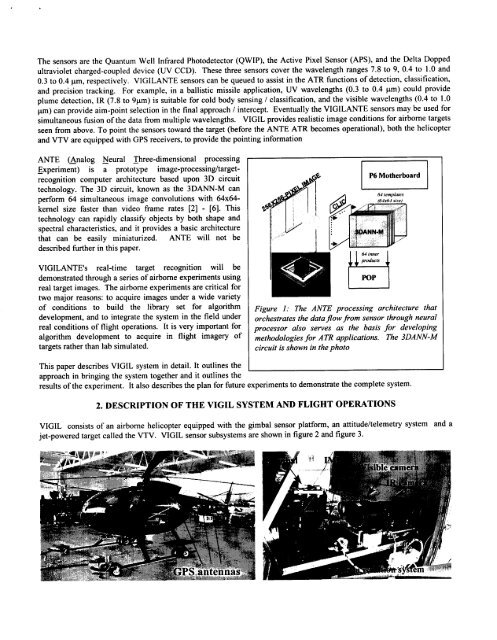
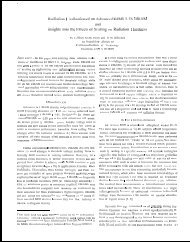


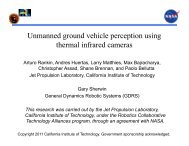



![Ana]ysis of Reaction Products and Conversion Time in the Pyrolysis ...](https://img.yumpu.com/11715548/1/190x242/anaysis-of-reaction-products-and-conversion-time-in-the-pyrolysis-.jpg?quality=85)
